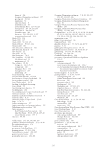20 – Sustainable management of the Lake Eyre Basin rivers 207 capacity, compression facilities and pipelines within HPAs and SFMAs, arguing that it improved safety for remote workers and improved efficiency of the petroleum and gas industry. The Labor Government (elected in 2015) made an election commitment to reinstate the protective provisions of the Wild Rivers legislation to the rivers and ecosystems of the Queensland part of the Lake Eyre Basin but there is no progress on this commitment. The 2012–15 political regime of the Liberal National Party During the 2012 Queensland election campaign, the Liberal National Party foreshadowed revocation of all Wild Rivers declarations in Queensland. Once in government, Premier Newman appointed the Honourable Andrew Cripps as Minister for Natural Resources and Mines, directing him to find alternative strategies to protect Western Rivers, while allowing sustainable development (Western Rivers Advisory Panel 2013). Minister Cripps established the Western Rivers Advisory Panel (WRAP), representing local government, AgForce (the peak agricultural stakeholder group in Queensland), the resources sector, an Indigenous representative, a scientific representative from the Lake Eyre Basin Scientific Panel, and natural resource management groups including the Cooper Creek Catchment Committee, the Georgina/Diamantina Catchment Committee and Desert Channels Queensland, the natural resource management group (Western Rivers Advisory Panel 2013). Minister Cripps proclaimed at the first Western Rivers Advisory Panel meeting that he would replace the Lake Eyre Basin Wild Rivers declarations with alternative strategies for river protection. The Western Rivers Advisory Panel was asked to provide advice on the important natural values of the Lake Eyre Basin and the option for expanding ‘small scale’ irrigation. The Queensland Department of Natural Resources and Mines surveyed Western Rivers Advisory Panel members about these values and assets, the focus and level of their protection and the greatest threats to the health and sustainability of the region’s rivers. The highest 10 assets or values were: a weed- and pest-free environment access to groundwater maintenance of natural flows groundwater quality protection of wetlands and lakes protection of artesian springs health of aquatic fauna, health of riparian terrestrial fauna, health of native pastures and surface water quality (Western Rivers Advisory Panel 2013). Western Rivers Advisory Panel members ranked developments most likely to affect the rivers’ ecological sustainability. Invasive species were ranked first, then large-scale mining, followed by unconventional petroleum and gas extraction, out of 33 types of development (Western Rivers Advisory Panel 2013). Irrigated agriculture ranked sixth and conventional petroleum and gas extraction ranked eighth. These rankings were consistent with similar results from the members’ survey done by AgForce (AgForce, unpublished survey, January 2013). It was ironic that those high value assets, identified as most needing protection from ‘high concern development activities’, were well protected under the agreed water plans and Wild Rivers declarations. The government agency also consulted Western Rivers Advisory Panel members on the scale of ‘small scale irrigation’ appropriate for the rivers, given the directive from the government. There was no consensus, with stakeholders ranging from an irrigated area of 10 ha (160 ML/year water entitlement) to 100 ha for a commercial operation (1600 ML/year water entitlement). A ‘no irrigation’ option was not provided. Surprisingly, Ag Force advised
Downloaded from CSIRO with access from at 216.73.216.88 on Nov 13, 2025, 2:31 AM. (c) CSIRO Publishing

















































































































































































































































































